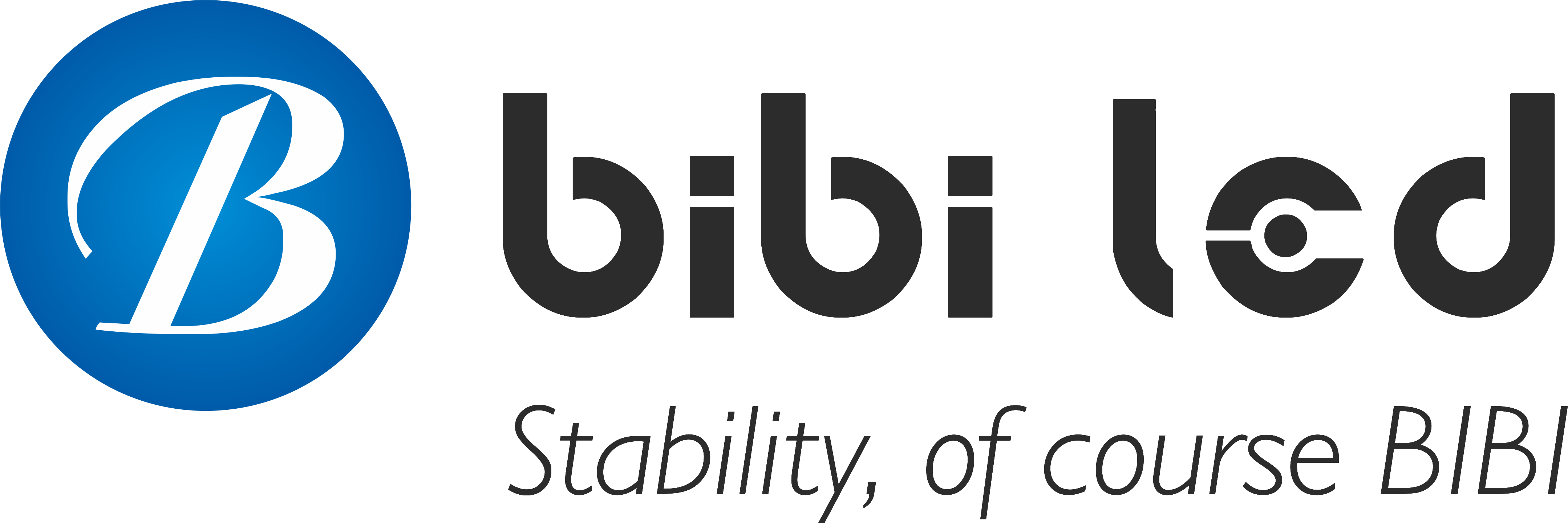Introducción
When driving on the highway, doesn’t a bright cartelera led suddenly appear in front of you, instantly catching your eye?
Think about it: in the fast-moving traffic of a highway, what kind of advertisement can grab a driver’s attention in just a few seconds? The answer is LED billboards!
Tabla de contenido
1. Why are LED advertising screens so effective for highway advertising?
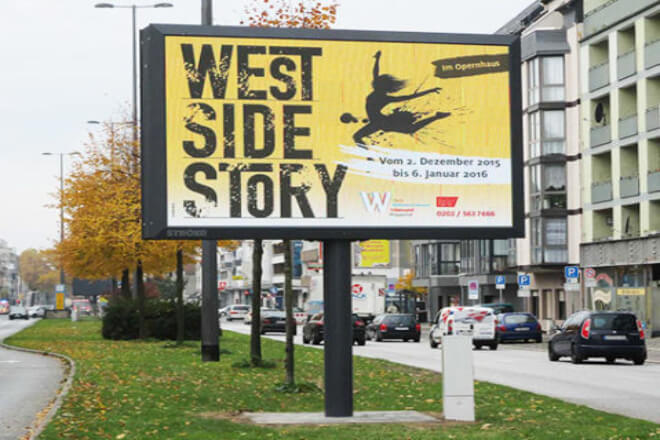
The purpose of highway advertising is to capture the attention of drivers and passengers, and pantallas publicitarias led, with their visual impact, flexibility.
And all-weather adaptability, have become the most popular form of advertising on highways. So, why are they so effective? Let’s take a look.
1) High visibility and all-weather adaptability
Whether under the scorching sun or under the starry night, LED advertising screens ensure your advertisement is clearly visible.
During the day, strong sunlight won’t blur the advertisement; the brightness of the LED display screen still allows every passing driver to see the advertisement content.
At night, the high brillo of the LED screen makes it brighter than the surrounding environment, allowing drivers to easily see the advertisement and not miss any promotional information.
This 24/7 adaptability means that advertisements can attract customers’ attention at the most crucial moments, no matter when.
2) Dynamic Content Display
Unlike traditional static advertising screens, LED advertising screens can display videos, animations, and dynamic effects, making advertisements appear more vibrant.
Imagine a driver seeing a video displaying delicious burgers or a fast-moving discount advertisement—it immediately grabs their attention.
Static advertising screens, on the other hand, may only display short text and images, which are easily overlooked.
The dynamic display effects of LED advertising screens make them a “visual feast,” causing customers to unconsciously stop while driving and even consider “trying out that discount.”
3) Flexible Updates and Content Control
Another major highlight of LED advertising screens is their flexibility. Advertisers can update content at any time based on time, season, and traffic conditions.
For example, displaying “brunch specials” during the morning rush hour and switching to “dinner discounts” or “seasonal menu recommendations” in the afternoon or evening. This keeps the advertising content fresh and avoids outdated information.
You no longer need to worry about advertisements expiring or needing frequent material changes. All content can be adjusted in real time to perfectly meet customer needs.
4) Remote Management and Monitoring
For advertisers, LED advertising screens are no longer “place and forget” devices.
Through a remote management system, advertisers can control the displayed content, brightness, and even monitor the screen’s operational status anytime, anywhere.
Want to modify an advertisement or add urgent promotional information? Simply operate on your mobile phone, and it will take effect immediately.
This convenience ensures advertisers no longer worry about missing the best opportunity, guaranteeing that advertising content is always in its most effective state.
2. How do LED advertising screens increase the exposure of highway advertising?
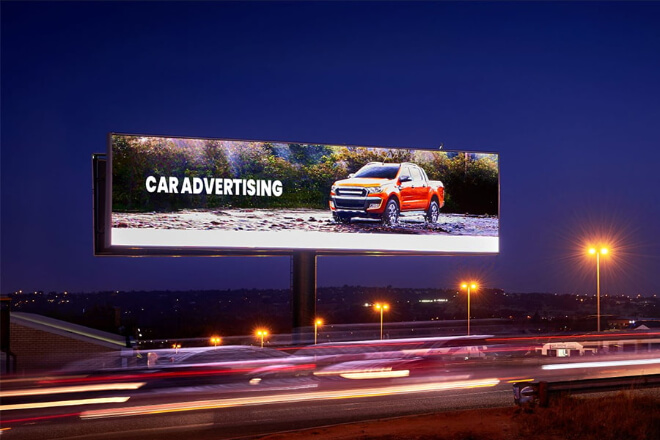
1) Large Area Coverage
LED advertising screens are typically much larger than traditional advertising screens, meaning they can be seen for a longer period in traffic.
On highways, cars travel at high speeds and in short periods, but the large display area of LED advertising screens ensures that every passing vehicle sees the advertising content.
Whether you’re walking fast or slow, LED advertising screens will grab your attention, making you unconsciously take a second look.
2) Alto Brillo and Clarity
When driving, if the brightness of an advertising screen is insufficient, the image will become blurry under sunlight, and no one wants to waste time trying to decipher the advertisement.
The high brightness of LED advertising screens ensures clear visibility even during the day, especially under direct sunlight, guaranteeing that the image remains unaffected and drivers can easily see the advertisement content.
At night, the brightness of LED advertising screens automatically adjusts to ensure clear visibility even in dim lighting, maintaining their appeal.
3) Dynamic Images
On highways, people’s attention spans are very limited, and static advertisements are often easily overlooked.
Dynamic images and videos on LED advertising screens easily overcome this limitation.
Imagine a driver seeing a video of a delicious hamburger or an eye-catching discount animation playing on a screen amidst rushing traffic—who wouldn’t want to stop and try it?
Dynamic images and animations are more vivid and attention-grabbing than static advertisements, allowing drivers to capture the advertising information within seconds.
4) Flexible Display of Multiple Advertising Content
LED advertising screens don’t just display a single fixed message; they can adjust the displayed content based on time, season, and even traffic conditions.
For example, they can display breakfast deals or coffee specials in the morning, switch to dinner discounts in the evening, or showcase special events on holidays.
Flexible content updates make advertising more targeted, attracting customers at different times of day and increasing ad frequency and exposure.
5) All-Weather Display
LED advertising screens can adapt to the vast changes in light, from strong daytime light to dim nighttime light.
They automatically adjust their brightness according to ambient light, providing a strong visual impact during the day and automatically adjusting at night to avoid excessive light interference.
This ensures that LED advertising screens consistently attract attention and maintain optimal display effects regardless of the time of day.
3. Application Scenarios of LED Advertising Screens in Highway Advertising
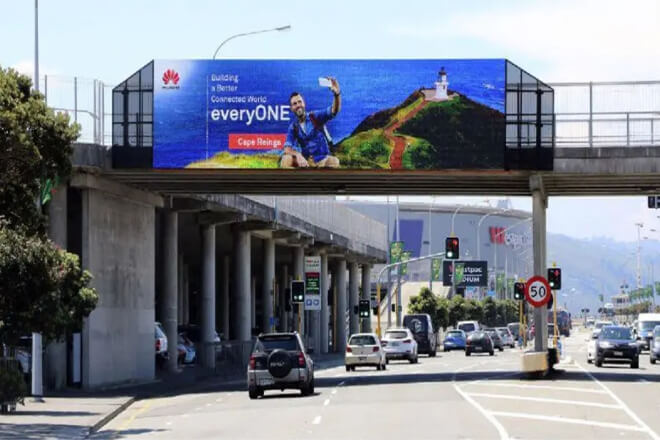
1) Highway Entrance and Exit Areas
Highway entrance and exit areas are essential routes for vehicles entering and leaving cities.
Drivers’ eyes are easily drawn to roadside advertisements while driving in these areas.
Therefore, setting up LED advertising screens in these entrance and exit areas not only maximises the display of advertising content but also effectively reaches high-traffic driver groups.
For example, setting up LED screens at a highway entrance or exit to display local tourist attractions, food recommendations.
Or upcoming events can prompt drivers entering the city to plan their itinerary in advance, even considering stopping for a rest or sightseeing.
These high-exposure areas are prime locations for brand promotion and city advertising.
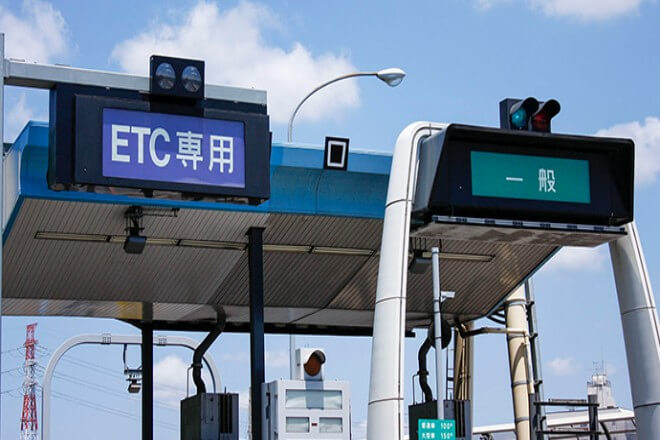
2) Transportation Hubs and Toll Stations
Highway toll stations and transportation hubs are places where vehicles temporarily stop. pantallas publicitarias led can be very effective during these “waiting” moments.
While waiting to pay tolls or rest, drivers and passengers are often drawn to surrounding advertisements.
At this time, LED advertising screens displaying merchant discounts, local food, gas station discounts, etc., not only pass the time but also stimulate consumption.
Especially during long-distance travel, drivers may stop briefly at toll stations. The “instant attraction” of LED advertising screens can convey effective information in a short time, helping businesses and brands quickly capture potential customers.
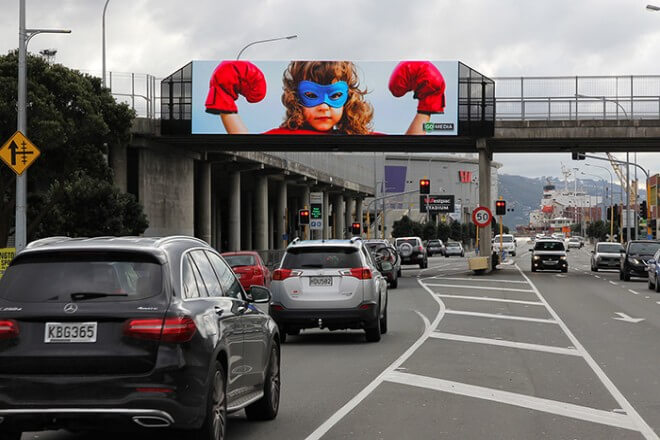
3) Promotion of Large-Scale Events or Competitions
LED advertising screens along highways are ideal for promoting large-scale events or competitions.
For example, when a major sporting event, concert, or festival is about to take place, LED advertising screens can display preview information and highlights of the event on busy highway sections, attracting spectators from long distances.
Utilising the dynamic content display of LED advertising screens, creative videos and animations can depict exciting scenes of the event, stimulating drivers’ interest and encouraging them to participate or travel to the event.
In addition, LED advertising screens can also display traffic routes, parking information, etc., before the event starts or around the event venue, providing customers with more convenient traffic guidance.
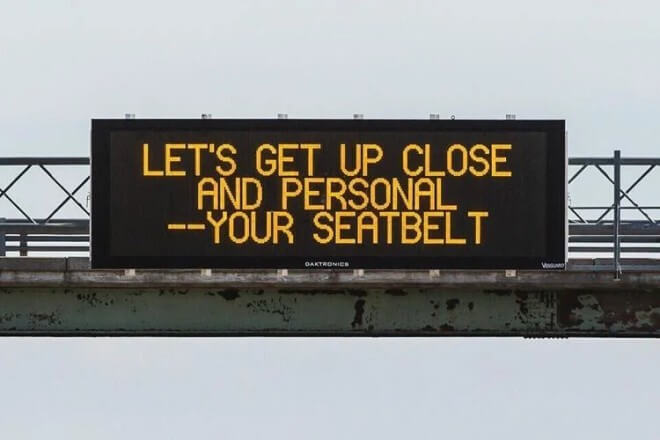
4) Traffic Safety Information Dissemination
LED advertising screens are not only tools for commercial promotion; they can also disseminate important traffic safety information in emergencies.
During peak hours on highways or in the event of a traffic accident, LED advertising screens can display real-time public information such as traffic safety reminders, weather warnings, and accident information.
For example, in foggy or rainy weather, LED advertising screens can promptly display warnings such as “Caution: Drive Safely,” “Speed Limit,” or “Accident Ahead, Slow Down,” reminding drivers to prepare for safety.
This real-time updating function greatly enhances the public service function of LED advertising screens and raises road safety awareness.
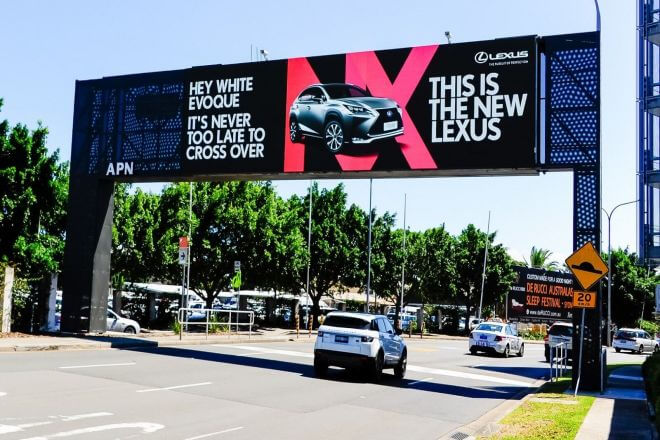
5) Brand Promotion and Business Advertising
Another important use of LED advertising screens is brand promotion and business advertising.
Various types of vehicles pass along highways, and LED advertising screens can display brand information, promotional activities, or new product recommendations from businesses at different times.
Whether it’s hoteles, restaurants, car services, or gas stations, businesses can use LED advertising screens to attract the attention of passing vehicles and encourage them to stop and patronise the establishment or choose related services.
In areas with multiple businesses along the route, LED advertising screens can rotate different advertising content to ensure maximum advertising exposure and coverage.
4. How do LED advertising screens help advertisers improve advertising effectiveness and ROI?

LED advertising screens not only attract attention but also help advertisers significantly improve advertising effectiveness and return on investment.
Want to know how it does it? Let’s take a look!
Unlike traditional advertising that’s “put on and forgotten,” LED advertising screens allow advertisers to track ad performance in real time.
Through data analysis, advertisers can see the performance of their ad content, such as which time periods are most effective and which content is most appealing to viewers.
This allows advertisers to optimise ad content and placement strategies based on this data, ensuring every penny is well spent.
For example, if a promotional ad displayed at night receives a better response, the advertiser can increase similar content during the evening hours to improve ad effectiveness.
Another major advantage of LED advertising screens is their flexibility. Advertisers can precisely adjust ad content based on traffic flow, holidays, or different time periods.
For example, during the morning rush hour, “Breakfast Special” can be displayed, while in the evening, it can switch to “Dinner Discount” or “Evening Special.”
This precise targeting not only improves ad relevance but also ensures that ads attract more viewers at the optimal time.
Just like the restaurant discount ads you see on Friday nights, they’re more likely to make you think, “I’ll eat here tonight,” than regular ads at lunchtime.
Highways, busy streets, and transportation hubs are prime locations for advertisers.
The huge display screens and dynamic effects of LED advertising screens ensure extremely high exposure in these high-traffic areas.
Compared to traditional static advertising screens, LED advertising screens attract the attention of passing drivers and pedestrians.
For example, if you’re driving and are suddenly drawn to a flashing advertisement, you might stop and buy a coffee.
This high exposure not only attracts viewers’ attention in a short time but also helps solidify the brand image in their minds.
The flexibility of LED advertising screens also extends to cost. Unlike traditional advertising screens, LED advertising screens can be reused.
And the content can be updated at any time, avoiding the high costs of frequently changing advertising materials.
Advertisers don’t need to create new ads every time; a simple backend operation allows for rapid content updates, saving significant costs on ad production and maintenance.
Furthermore, LED advertising screens have a long lifespan and are easy to maintain, reducing long-term operational expenses and offering excellent value.
The high visual impact and creative displays of LED advertising screens quickly attract viewers’ attention and stimulate their desire to buy.
Compared to static ads, LED advertising screens can better convey brand information through dynamic content such as videos and animations, breaking visual fatigue.
Advertisers can directly drive consumers to make purchasing decisions through vivid content displays, such as limited-time discounts, new product recommendations, and special sales events.
Imagine seeing a dynamic promotional ad during peak hours; you immediately think, “Maybe I should check it out.” This is the magic of LED advertising screens in improving conversion rates.
5. How to Choose the Right LED Advertising Screen System?
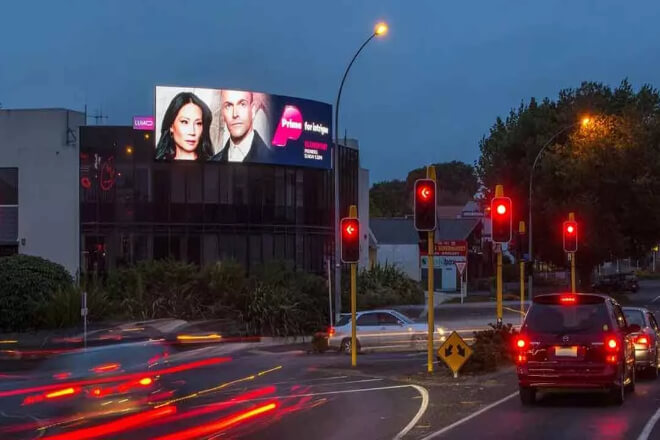
1) Display Technology Selection
First, choosing the right LED screen type is crucial, based on the content you want to display and the environment.
If you’re setting up an advertising screen on a highway, you need to ensure the screen can adapt to all-weather advertising display.
Outdoor full-colour LED screens are the most common choice, capable of displaying rich colours and dynamic content, attracting the attention of drivers and passengers.
However, if you want to display more transparent, artistic advertising content, pantallas LED transparentes are more suitable.
They not only display advertising information but also maintain light transmission, meeting modern design needs.
Simply put, choosing the right display technology is based on your advertising needs: what kind of effect and display format do you need?
Full-colour, transparent, or another type of LED screen? This step is crucial.
2) Size and Resolución
The size and resolution of the LED advertising screen directly affect the display effect of the advertisement.
On highways, where vehicles travel at high speeds, the advertising screen needs to be large enough for passing drivers to see the content clearly within a few seconds.
At the same time, resolution is also very important. Low-resolution LED screens may result in blurry images, affecting advertising effectiveness.
Therefore, it’s necessary to choose a high-resolution LED screen to ensure content is clearly visible, even from a distance.
Therefore, the first step is to determine the size of the advertising screen, which depends not only on the budget but also on the location and the surrounding environment.
Secondly, ensure the resolution is high enough for the advertising content to be clearly displayed.
3) Brillo and Anti-glare Design
Brightness is crucial for LED advertising screens, especially in environments like highways, where direct sunlight and differences in nighttime lighting can affect display quality.
Under strong sunlight, ordinary displays may appear dim, while high-brightness LED advertising screens ensure clear visibility and attract drivers’ attention.
When choosing, it’s recommended to select a high-brightness LED screen (generally requiring 5000-6000 nits) with adjustable brightness to ensure clear display of advertising content day or night.
4) Waterproofing, Dustproofing, and Durability
Highway LED advertising screens are exposed to the outdoor environment for extended periods; therefore, durability and protection are paramount.
Exposed to wind, sun, rain, and snow, LED screens must possess excellent waterproof and dustproof capabilities to ensure long-term, uninterrupted operation.
Generally, LED advertising screens need to achieve an IP65 protection rating, effectively resisting rain and dust.
Furthermore, durability is also a key consideration. After long-term use, the colour and brightness of the LED screen should not degrade, and the screen should maintain a high display effect.
5) Remote Control and Management System
Managing advertising content is another important aspect of an LED advertising screen system.
A remote control system is crucial for adjusting advertising content anytime, anywhere.
Choosing an LED advertising screen system that supports remote control and real-time updates allows advertisers to adjust screen content via the network at any time, quickly responding to market and customer needs.
In addition, fault alarm functions are essential. In case of a malfunction, the system will automatically notify management personnel to handle the problem promptly and prevent advertising interruptions.
6. Conclusion
Having read this, do you also feel that LED billboards are playing an increasingly indispensable role in highway advertising?
Whether it’s high brightness, all-weather display, or flexible playback of dynamic content, LED billboards can instantly attract drivers’ attention, increase advertising exposure, and even enhance brand awareness.
Finally, if you would like to learn more about LED displays, Por favor póngase en contacto con nosotros.
